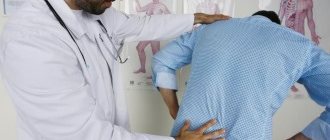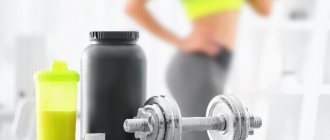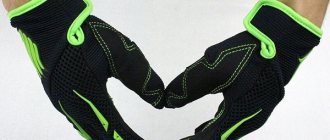- home
- Articles about training
- Muscle pain after exercise
Physical activity is beneficial for the body - this is a proven fact that does not raise doubts. Regular exercise improves well-being, quality of life, speeds up metabolism, helps maintain flexibility and mobility of the body, promotes the growth of muscle mass and increases endurance.
But all these positive aspects are slightly overshadowed by one unpleasant side effect from sports training: muscle pain of varying intensity. Pain syndrome most often occurs in beginners after the first exercises, but even if you are an experienced athlete, muscle pain probably accompanies you during periods of high-intensity loads or when performing weight-bearing exercises.
Many, having felt pain after sports activities, succumb to a common misconception and consider it a sign of a well-done workout and a manifestation of an increase in muscle mass: “it hurts, it means it’s growing.” In fact, severe muscle pain and the inability to move normally the next day, as a rule, are the result of ordinary non-compliance with the exercise technique. Let's take a closer look at what happens in the muscles during training and why pain occurs.
Causes of muscle pain after exercise
There are two types of muscle pain that appear at the initial stage of sports activities, which are considered natural and therefore safe.
One occurs right during training, at the moment when you perform the last, heaviest repetitions of the exercises. Why is this happening?
During training, ATP (adenosine triphosphoric acid), which is the most important source of energy, begins to decompose in muscle tissue and blood. Because of this, hydrogen ions accumulate in the blood and muscles, and the pH of the blood begins to shift towards oxidation. It is because of the “acidification” of the blood that a burning sensation occurs. It passes quite quickly: blood and increased air ventilation in the lungs help the body cope with the accumulated hydrogen ions. But all subsequent pain is associated with microdamage in muscle tissue.
The second is the so-called sore throat, or delayed muscle pain.
It occurs 6-8 hours after physical activity and reaches a maximum after about 2-3 days. As a rule, its appearance is a consequence of unusual or excessively intense physical activity. You have most likely experienced yourself more than once: not only at the very beginning of fitness classes, but also when mastering new sets of exercises or increasing their duration and intensity. This type of pain is caused by microscopic damage or even tears in muscle fibers.
A large number of muscle microdamages inhibit the growth of muscle tissue. This is because muscle growth requires amino acids, which are also needed to heal damaged muscles. Severe damage to muscle tissue “steals” amino acids for healing, thereby preventing muscle fibers from growing.
Traumatic causes of muscle pain
The exact opposite of natural pain is severe pain resulting from injury. This pain is aching in nature, intensifies even with minor exertion and becomes unbearable with sudden movement.
The pain syndrome appears immediately during training, sometimes the next day.
If you experience redness and swelling of the tissues, bruising, or general malaise, this clearly indicates a serious injury to the muscles and ligaments. In this case, do not delay going to the doctor!
The biggest cause of injuries in the gym is carelessness. To avoid unpleasant consequences, it is enough to follow a few simple rules. Not worth it:
- start straight away with heavy exercises, skipping the warm-up
- continue to exercise on exercise machines, experiencing any inconvenience
- take on excessive weight during strength training
- During training, ignore the appearance of crunching or clicking in the joints
And don’t forget to listen to your trainer’s advice: under the guidance of our trainers, you can not only get the desired effect, but also learn how to take care of your training safety.
Types of training
Conventionally, full-fledged training in the gym can be divided into three types:
- Power. Predominantly anaerobic exercise, a lot of work in machines or with free weights, performing exercises in a low to medium repetition range, using heavy working weights; goals are to increase strength and gain muscle mass.
- Cardio. Mainly aerobic exercise, work occurs within a certain heart rate zone; goals are to accelerate metabolism, develop endurance, burn fat, support the cardiovascular system.
- Functional. A combination of aerobic and anaerobic exercise, work occurs at a high heart rate, there is both work with maximum weights and cardio exercise; goals – development of strength endurance, improvement of the functional qualities of the body).
They are all fundamentally different from each other, and your body will perceive them differently. Cardio training usually takes place at low intensity and in a relatively low heart rate zone, so deterioration in well-being after it is less likely. With strength training and CrossFit, things are different because throughout your workout you:
- repeatedly reach submaximal heart rate levels;
- in most cases, you do not allow the body to restore all systems during the rest period between approaches (which usually does not exceed 1-2 minutes);
- you work with heavy weights, which overloads your joint-ligamentous apparatus;
- spend more energy on exercise, which leads to a calorie deficit;
- you consume a lot of water and mineral salts.
All this leads to poor health after training. Let's try to understand in more detail why exactly this happens.
How to get rid of pain after exercise
We've looked at the causes of pain, now let's talk about how to get rid of it. Safe types of pain can be relieved directly during exercise by repeating the exercise that caused it, but with less load. These actions will remove muscle stiffness and ensure increased blood flow, carrying oxygen and nutrients necessary for regeneration to the tissues.
Discomfort in the muscles of the legs and lower body can be relieved with cardio exercises, and pain in the muscles of the upper body can be relieved by doing bodyweight exercises or doing yoga.
If we talk about relieving soreness, there are several effective methods that can quickly relieve pain.
Proper nutrition and sleep patterns
This is of paramount importance for the restoration of muscle tissue. After hard training, your muscles need proteins and carbohydrates: the former supply the amino acids needed for the rapid healing of micro-tears, and the latter provide the muscles with glycogen. Drinking at least 2 liters of water per day helps remove toxins from the body and prevents dehydration, which leads to muscle fatigue (however, do not overdo it: drinking too much causes the kidneys to work too hard). Don't forget about rest: stick to a routine, try not to go to bed too late and sleep at least 8 hours. Adequate, healthy sleep will help you regain your strength and prepare for new workouts.
Relaxing massage
Massage is a very effective method of getting rid of sore throat.
It relieves muscle tension, disperses lymph, increases muscle elasticity and relieves stiffness. The Body&Mind studio knows how to properly recover after sports: a new sports massage service will help you regain strength and well-being after a quality workout. Look for Massage'30 and Massage'60 in the schedule and sign up for a relaxing massage session.
Hot bath or sauna
The sauna at The Base is a great way to relieve muscle pain! During your stay in the sauna, blood vessels dilate, which increases the volume of blood in muscle tissue, promotes the removal of toxins and speeds up the recovery process.
Basic provisions
- A massage given immediately after training is the best way to relieve soreness and muscle fatigue.
- If massage is not possible, tight clothing and immersion in water will help.
- The recovery methods outlined in the review do not replace the classic recommendations about the need for good sleep and high-calorie protein nutrition, they simply help you recover faster and train more efficiently.
Athletes involved in strength sports believe that recovering from training requires even more effort than training. In order for the muscles to be voluminous and strong, training must be long and intense, and a person who does not know how to recover after them simply cannot withstand such a regime and will not achieve the effect.
French researchers analyzed 99 studies and compared the effectiveness of 10 recovery techniques, assessing their effect on muscle pain, fatigue, markers of inflammation and muscle damage. Massage turned out to be the most effective remedy. But this is an expensive pleasure. Fortunately, there are more budget-friendly means - tight clothing and immersion in water whose temperature is lower than body temperature. These methods relieve pain and fatigue well. Recovery methods such as stretching and active recovery methods have a contradictory effect: they alleviate pain, but at the same time increase fatigue a day after training.
How to avoid muscle pain after exercise
The best thing, of course, is simply to prevent pain from occurring. The simplest and most effective way to avoid pain after exercise is to approach your workouts wisely. You shouldn’t overload your muscles at the very first lesson: experienced trainers at The Base club advise increasing the load little by little, constantly adjusting its duration and intensity. In addition, never waste time on warming up and cooling down.
Warm-up
This is a necessary element of any workout, reducing the risk of injury, warming up the muscles, reducing their stiffness and relieving the athlete of pain after exercise.
Cool down and stretch
You need to finish any workout with simple exercises for all muscle groups, light jogging and stretching. This will help get rid of the lactic acid that has accumulated in the muscles during exercise.
results
As a result, French researchers selected and analyzed 99 publications, 80 of which looked at the effect of restorative methods on strength, 17 on fatigue, 19 on markers of inflammation and 37 on signs of muscle damage. They analyzed active recovery (light, short workouts), stretching, massage, massage plus stretching, electrical stimulation, shapewear, water immersion, contrast water treatments, cryotherapy, and hyperbaric therapy.
In general, restorative techniques are effective in relieving muscle pain and fatigue. For some reason, they help men better than women. Active recovery, massage, shapewear, immersion, contrast water treatments and cryotherapy significantly alleviate muscle pain, while stretching, electrical stimulation and hyperbaric therapy have proven to be virtually useless. For the relief of delayed onset muscle pain syndrome, massage turned out to be unrivaled (Fig. 1).
Massage, tight clothing and immersion in water cooler than body temperature worked well against fatigue (different methods suggest water colder than 15°C or with a temperature from 15 to 35°C). Stretching, electrical stimulation and contrast water treatments were ineffective, and active recovery even slightly increased the feeling of fatigue 24 hours after training. The number one remedy for fatigue is massage (Fig. 2).
Molecular markers of muscle damage and inflammation included elevated levels of creatine kinase, interleukin-6, and C-reactive protein. Restorative procedures, whatever they were, had little effect on the concentration of these markers in the blood plasma. An increase in the activity of the creatine kinase enzyme indicates, among other things, damage to skeletal muscle fibers. Massage slightly reduces the level of creatine kinase, while stretching, on the contrary, slightly increases it. Massage and cryotherapy reduce the concentration of interleukin-6, an indicator of inflammation. All three markers are well affected by immersion in water below body temperature; water warmer than 35°C does not reduce their concentration.
Other reasons
Almost any disease of the internal organs can lead to myalgia11. When an organ is affected, it creates pain impulses that are partially transmitted to the muscles located nearby11.
Myalgia can also be caused by:
- endocrine diseases, such as thyroid hormone deficiency16,7;
- vascular pathologies that disrupt the nutrition of the muscles of the limbs15,16;
- chronic fatigue syndrome7;
- imbalance of microelements in the body16;
- taking medications that lower blood cholesterol levels12.
to come back to the beginning
Muscle fatigue
In our technological age, many people are gradually forming a new “bad habit”. Spending most of the day in front of a computer screen or holding mobile gadgets in our hands, we may not even notice that we are sitting in a completely uncomfortable and unnatural position. It especially affects the muscles of the shoulder girdle, neck, back and right arm, which is constantly on the computer mouse of office workers1. Staying in one position for a long time or using stereotyped movements can lead to overstrain of the muscles involved, which we feel as soreness1.
Features of myalgia
Pain emanating from the muscles is usually deep6. Acute myalgia is protective in nature because it causes reactions aimed at eliminating the damaging factor11. Such reactions include, for example, muscle spasms4. But despite its protective nature, there is almost always a risk that the pain will become chronic11. There are 2 main causes of chronicity:
- Increased sensitivity. In response to irritation, the muscle releases substances that support inflammation. They further irritate pain receptors in the muscles. In response to frequent signals, the central nervous system lowers the pain threshold, so we can feel soreness in the muscle even when it is not strongly irritated11.
- Spasm. If pain and spasm persist, a “vicious circle” is formed: pain causes spasm, and spasm maintains pain1,5, 11.
Diseases of the spine and joints
Muscles react to disruption of the joints4 and vertebrae5 associated with them. Therefore, myalgia is one of the symptoms of diseases of the spine5,11 and joints of the limbs4. For example, with osteochondrosis or scoliosis (curvature of the spine), pain in the neck, chest or lower back is associated with overstrain of the paravertebral muscles5,11. And in advanced cases, when the vertebra compresses the nerve root emerging from the spinal cord, the pain can “radiate” to the arm or leg11.
Often myalgia with osteochondrosis is combined with a feeling of numbness or “crawling goosebumps”. At the moment of acute pain, a person freezes, taking a forced position11.











